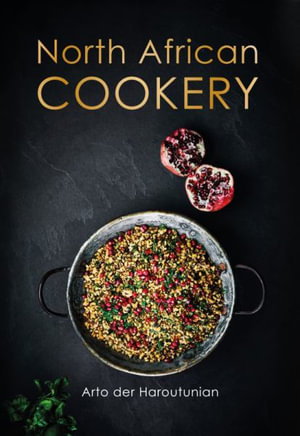| Sun | 10am – 5pm |
| Mon | 9am – 5:30pm |
| Tue | 9am – 5:30pm |
| Wed | 9am – 5:30pm |
| Thu | 9am – 5:30pm |
| Fri | 9am – 7pm |
| Sat | 9am – 5pm |
Ask our staff anything about our shop or products, or share your feedback.

PublishedGrub Street, June 2023 |
ISBN9781911667469 |
FormatHardcover, 384 pages |
Dimensions24cm × 17cm |
Arto der Haroutunian takes adventurous cooks on a tour of the cuisines of Morocco, Algeria, Tunisia and Libya in this comprehensive guide to North African food. There are over 300 recipes for traditional dishes such as tagines, stews, soups, and salads using classic ingredients such as fiery spices, jewel-like dried fruits, lemons, and armfuls of fresh herbs.
Simplicity is at the heart of the medina kitchen. The exotic fuses with the domestic to produce dishes that are highly flavoured yet quick and easy to prepare. Vegetables are prepared in succulent and unusual ways while dishes such as chicken honey and onion couscous, and 'gazelle horns' filled with almonds, sugar and orange blossom water provide a feast for both the imagination and the palate. Tunisian cuisine is perhaps the hottest of the region-due in large part to the popularity of the fiery chilli paste, harissa. As well as a strong French influence, pasta is a passion in Tunisia. Morocco's great forte is its tagines and sauces-with meat and fish being cooked in one of four popular sauces. And Libya, although less gastronomically subtle than Tunisia and Morocco, excels in soups and patisserie. This collection represents the cooking of the region with refreshingly uncomplicated techniques, short lists of ingredients and the comforting, elemental flavours of various spices and seasonings. Recipes are easy to follow, and evoke the spicy, sumptuous flavours of the region. This culinary journey creates some of the world's most extraordinary gastronomic cultures. With a sumptuous range of dishes from simple street fare to elaborate banquet food, this book is a wonderful introduction to North African flavoured with a slice of history, an anecdote or a fable that brings this 'land of the sunset' vividly to life. AUTHOR: Arto der Haroutunian was born in Aleppo, Syria in 1940 and grew up in the Levant, but came to England with his parents as a child and remained here for most of his life. He studied architecture at Manchester University and established a career designing restaurants, clubs and hotels. In 1970, in partnership with his brother, he opened the first Armenian restaurant in Manchester which eventually became a successful chain of six restaurants and two hotels. He died in 1987 at the untimely age of 47. He is survived by his wife and son who still live in Manchester. His other interests included composing music and translating Turkish, Arab, Persian and Armenian authors. He was a true polymath and his cookery books combined his love of food with his great interest in history and culture.

